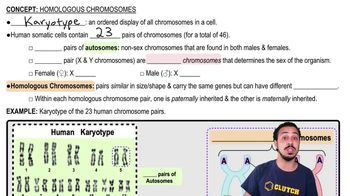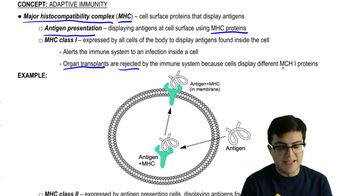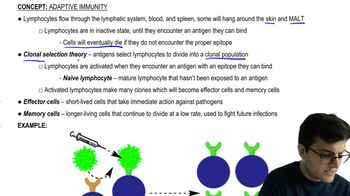Table of contents
- 1. Introduction to Biology2h 42m
- 2. Chemistry3h 40m
- 3. Water1h 26m
- 4. Biomolecules2h 23m
- 5. Cell Components2h 26m
- 6. The Membrane2h 31m
- 7. Energy and Metabolism2h 0m
- 8. Respiration2h 40m
- 9. Photosynthesis2h 49m
- 10. Cell Signaling59m
- 11. Cell Division2h 47m
- 12. Meiosis2h 0m
- 13. Mendelian Genetics4h 44m
- Introduction to Mendel's Experiments7m
- Genotype vs. Phenotype17m
- Punnett Squares13m
- Mendel's Experiments26m
- Mendel's Laws18m
- Monohybrid Crosses19m
- Test Crosses14m
- Dihybrid Crosses20m
- Punnett Square Probability26m
- Incomplete Dominance vs. Codominance20m
- Epistasis7m
- Non-Mendelian Genetics12m
- Pedigrees6m
- Autosomal Inheritance21m
- Sex-Linked Inheritance43m
- X-Inactivation9m
- 14. DNA Synthesis2h 27m
- 15. Gene Expression3h 20m
- 16. Regulation of Expression3h 31m
- Introduction to Regulation of Gene Expression13m
- Prokaryotic Gene Regulation via Operons27m
- The Lac Operon21m
- Glucose's Impact on Lac Operon25m
- The Trp Operon20m
- Review of the Lac Operon & Trp Operon11m
- Introduction to Eukaryotic Gene Regulation9m
- Eukaryotic Chromatin Modifications16m
- Eukaryotic Transcriptional Control22m
- Eukaryotic Post-Transcriptional Regulation28m
- Eukaryotic Post-Translational Regulation13m
- 17. Viruses37m
- 18. Biotechnology2h 58m
- 19. Genomics17m
- 20. Development1h 5m
- 21. Evolution3h 1m
- 22. Evolution of Populations3h 52m
- 23. Speciation1h 37m
- 24. History of Life on Earth2h 6m
- 25. Phylogeny2h 31m
- 26. Prokaryotes4h 59m
- 27. Protists1h 12m
- 28. Plants1h 22m
- 29. Fungi36m
- 30. Overview of Animals34m
- 31. Invertebrates1h 2m
- 32. Vertebrates50m
- 33. Plant Anatomy1h 3m
- 34. Vascular Plant Transport1h 2m
- 35. Soil37m
- 36. Plant Reproduction47m
- 37. Plant Sensation and Response1h 9m
- 38. Animal Form and Function1h 19m
- 39. Digestive System1h 10m
- 40. Circulatory System1h 57m
- 41. Immune System1h 12m
- 42. Osmoregulation and Excretion50m
- 43. Endocrine System1h 4m
- 44. Animal Reproduction1h 2m
- 45. Nervous System1h 55m
- 46. Sensory Systems46m
- 47. Muscle Systems23m
- 48. Ecology3h 11m
- Introduction to Ecology20m
- Biogeography14m
- Earth's Climate Patterns50m
- Introduction to Terrestrial Biomes10m
- Terrestrial Biomes: Near Equator13m
- Terrestrial Biomes: Temperate Regions10m
- Terrestrial Biomes: Northern Regions15m
- Introduction to Aquatic Biomes27m
- Freshwater Aquatic Biomes14m
- Marine Aquatic Biomes13m
- 49. Animal Behavior28m
- 50. Population Ecology3h 41m
- Introduction to Population Ecology28m
- Population Sampling Methods23m
- Life History12m
- Population Demography17m
- Factors Limiting Population Growth14m
- Introduction to Population Growth Models22m
- Linear Population Growth6m
- Exponential Population Growth29m
- Logistic Population Growth32m
- r/K Selection10m
- The Human Population22m
- 51. Community Ecology2h 46m
- Introduction to Community Ecology2m
- Introduction to Community Interactions9m
- Community Interactions: Competition (-/-)38m
- Community Interactions: Exploitation (+/-)23m
- Community Interactions: Mutualism (+/+) & Commensalism (+/0)9m
- Community Structure35m
- Community Dynamics26m
- Geographic Impact on Communities21m
- 52. Ecosystems2h 36m
- 53. Conservation Biology24m
41. Immune System
Adaptive Immunity
Problem 5`
Textbook Question
Which of the following should be the same in identical twins?
a. The set of antibodies produced
b. The set of MHC molecules produced
c. The set of T cell antigen receptors produced
d. The set of immune cells eliminated as self-reactive
 Verified step by step guidance
Verified step by step guidance1
Understand that identical twins originate from the same fertilized egg, meaning they have the same genetic material.
Recall that the Major Histocompatibility Complex (MHC) molecules are encoded by genes that are highly polymorphic, but identical twins have the same alleles for these genes.
Consider that the set of antibodies produced can vary due to environmental factors and exposure to different pathogens, even in identical twins.
Recognize that T cell antigen receptors are generated through a random recombination process, which can lead to differences even in genetically identical individuals.
Identify that the set of immune cells eliminated as self-reactive is influenced by the genetic makeup, which is identical in twins, leading to the same set of self-reactive cells being eliminated.
 Verified video answer for a similar problem:
Verified video answer for a similar problem:This video solution was recommended by our tutors as helpful for the problem above
Video duration:
3mPlay a video:
Was this helpful?
Key Concepts
Here are the essential concepts you must grasp in order to answer the question correctly.
Identical Twins
Identical twins, also known as monozygotic twins, originate from a single fertilized egg that splits into two embryos. This results in twins with identical genetic material, meaning they share the same DNA. This genetic similarity is crucial for understanding why certain biological characteristics, such as genetic markers, are the same in identical twins.
Recommended video:
Guided course

Homologous Chromosomes
Major Histocompatibility Complex (MHC)
The Major Histocompatibility Complex (MHC) is a set of cell surface proteins essential for the acquired immune system to recognize foreign molecules. MHC molecules are encoded by a highly polymorphic set of genes, meaning they vary greatly between individuals. However, identical twins have the same set of MHC molecules due to their identical genetic makeup, which is critical for tissue compatibility and immune response.
Recommended video:
Guided course

Major Histocompatibility Complex
T Cell Antigen Receptors
T cell antigen receptors are molecules found on the surface of T cells that allow them to recognize and bind to specific antigens. These receptors are generated through a process of genetic recombination, leading to a diverse repertoire in each individual. In identical twins, the genetic potential for producing T cell receptors is the same, but the actual set of receptors can differ due to random recombination events during immune cell development.
Recommended video:
Guided course

Antigen Receptors

 5:50m
5:50mWatch next
Master Adaptive Immune Response with a bite sized video explanation from Jason
Start learningRelated Videos
Related Practice


























































